Comparative Analysis of Risk Factors in Anorexia, Bulimia, and BED
VerifiedAdded on 2022/09/13
|6
|1241
|14
Report
AI Summary
This report provides a comprehensive overview of anorexia nervosa, bulimia nervosa, and binge eating disorder (BED), focusing on the various risk factors associated with each condition. For anorexia nervosa, the report highlights biological, diet-based, and transitional risk factors, including genetic predispositions, the impact of starvation on the brain, and environmental transitions. In the discussion of bulimia nervosa, the report emphasizes the higher prevalence in women and individuals with first-degree relatives with the disorder, along with psychological and emotional issues like anxiety and dieting habits. For BED, the report identifies biological factors such as dopamine exposure and hereditary links, as well as psychological factors like traumatic life events, negative body image, and a history of binging. The report also notes the connection between BED and obesity. The document concludes by referencing relevant studies that support the identified risk factors.
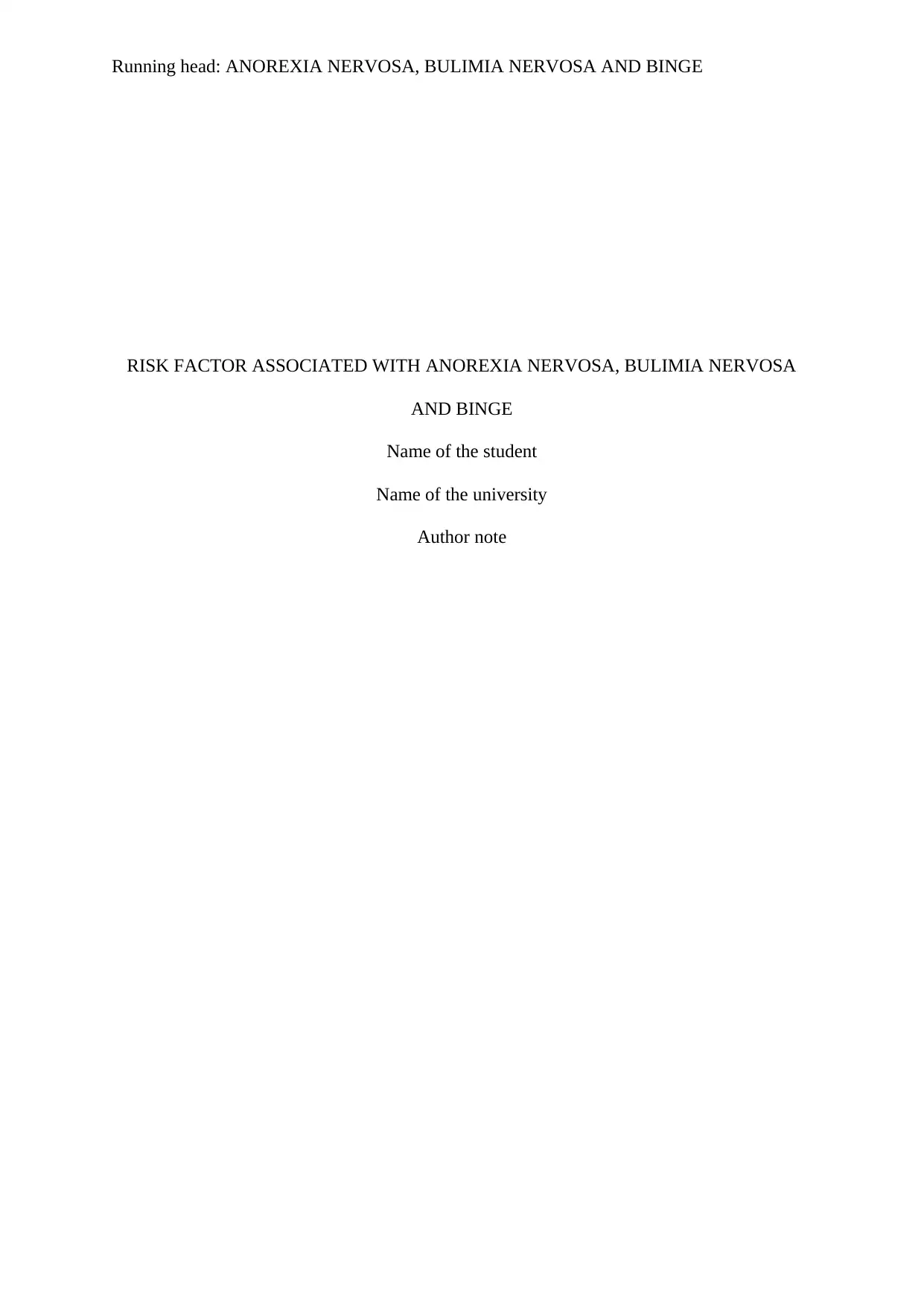
Running head: ANOREXIA NERVOSA, BULIMIA NERVOSA AND BINGE
RISK FACTOR ASSOCIATED WITH ANOREXIA NERVOSA, BULIMIA NERVOSA
AND BINGE
Name of the student
Name of the university
Author note
RISK FACTOR ASSOCIATED WITH ANOREXIA NERVOSA, BULIMIA NERVOSA
AND BINGE
Name of the student
Name of the university
Author note
Paraphrase This Document
Need a fresh take? Get an instant paraphrase of this document with our AI Paraphraser
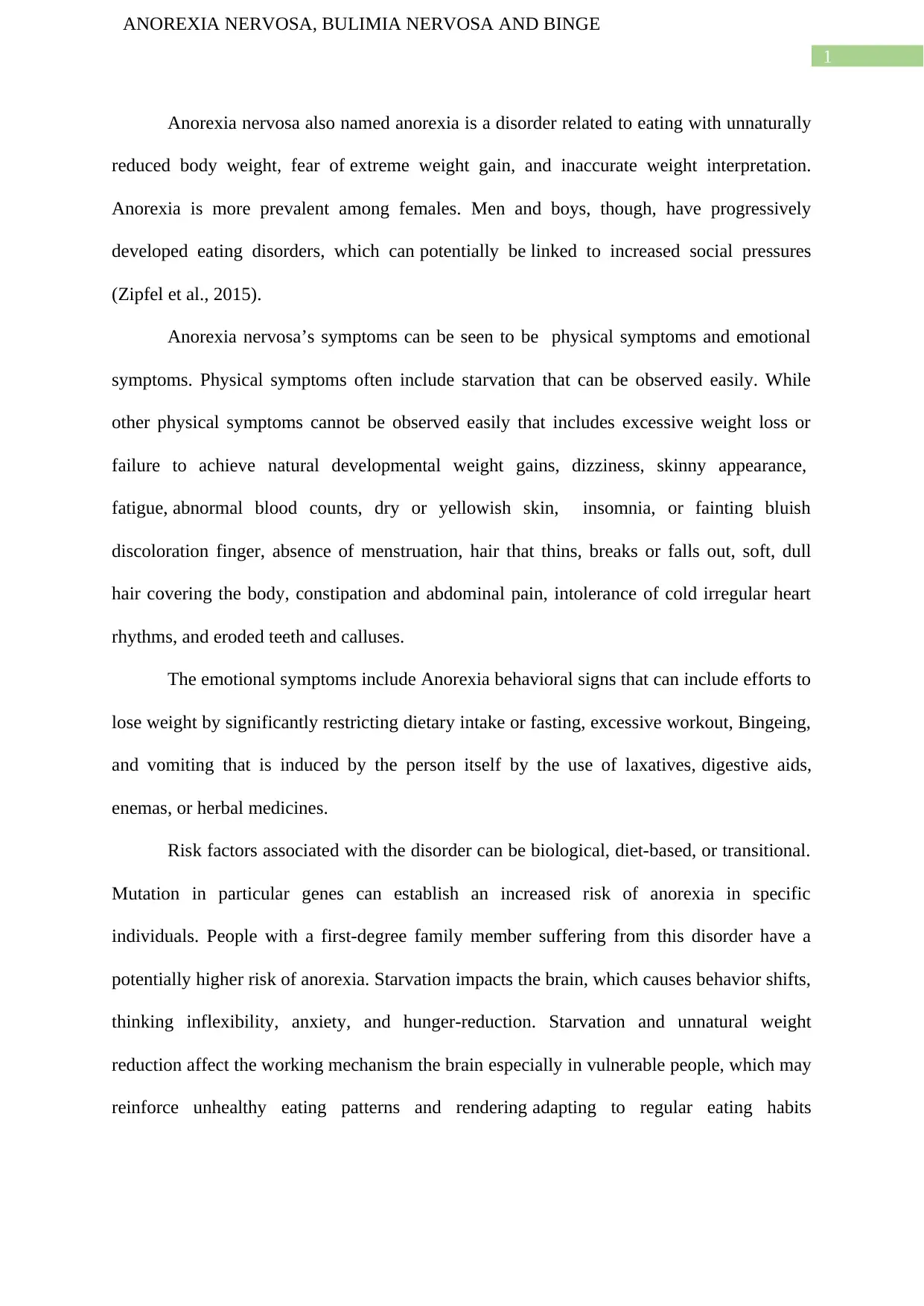
1
ANOREXIA NERVOSA, BULIMIA NERVOSA AND BINGE
Anorexia nervosa also named anorexia is a disorder related to eating with unnaturally
reduced body weight, fear of extreme weight gain, and inaccurate weight interpretation.
Anorexia is more prevalent among females. Men and boys, though, have progressively
developed eating disorders, which can potentially be linked to increased social pressures
(Zipfel et al., 2015).
Anorexia nervosa’s symptoms can be seen to be physical symptoms and emotional
symptoms. Physical symptoms often include starvation that can be observed easily. While
other physical symptoms cannot be observed easily that includes excessive weight loss or
failure to achieve natural developmental weight gains, dizziness, skinny appearance,
fatigue, abnormal blood counts, dry or yellowish skin, insomnia, or fainting bluish
discoloration finger, absence of menstruation, hair that thins, breaks or falls out, soft, dull
hair covering the body, constipation and abdominal pain, intolerance of cold irregular heart
rhythms, and eroded teeth and calluses.
The emotional symptoms include Anorexia behavioral signs that can include efforts to
lose weight by significantly restricting dietary intake or fasting, excessive workout, Bingeing,
and vomiting that is induced by the person itself by the use of laxatives, digestive aids,
enemas, or herbal medicines.
Risk factors associated with the disorder can be biological, diet-based, or transitional.
Mutation in particular genes can establish an increased risk of anorexia in specific
individuals. People with a first-degree family member suffering from this disorder have a
potentially higher risk of anorexia. Starvation impacts the brain, which causes behavior shifts,
thinking inflexibility, anxiety, and hunger-reduction. Starvation and unnatural weight
reduction affect the working mechanism the brain especially in vulnerable people, which may
reinforce unhealthy eating patterns and rendering adapting to regular eating habits
ANOREXIA NERVOSA, BULIMIA NERVOSA AND BINGE
Anorexia nervosa also named anorexia is a disorder related to eating with unnaturally
reduced body weight, fear of extreme weight gain, and inaccurate weight interpretation.
Anorexia is more prevalent among females. Men and boys, though, have progressively
developed eating disorders, which can potentially be linked to increased social pressures
(Zipfel et al., 2015).
Anorexia nervosa’s symptoms can be seen to be physical symptoms and emotional
symptoms. Physical symptoms often include starvation that can be observed easily. While
other physical symptoms cannot be observed easily that includes excessive weight loss or
failure to achieve natural developmental weight gains, dizziness, skinny appearance,
fatigue, abnormal blood counts, dry or yellowish skin, insomnia, or fainting bluish
discoloration finger, absence of menstruation, hair that thins, breaks or falls out, soft, dull
hair covering the body, constipation and abdominal pain, intolerance of cold irregular heart
rhythms, and eroded teeth and calluses.
The emotional symptoms include Anorexia behavioral signs that can include efforts to
lose weight by significantly restricting dietary intake or fasting, excessive workout, Bingeing,
and vomiting that is induced by the person itself by the use of laxatives, digestive aids,
enemas, or herbal medicines.
Risk factors associated with the disorder can be biological, diet-based, or transitional.
Mutation in particular genes can establish an increased risk of anorexia in specific
individuals. People with a first-degree family member suffering from this disorder have a
potentially higher risk of anorexia. Starvation impacts the brain, which causes behavior shifts,
thinking inflexibility, anxiety, and hunger-reduction. Starvation and unnatural weight
reduction affect the working mechanism the brain especially in vulnerable people, which may
reinforce unhealthy eating patterns and rendering adapting to regular eating habits
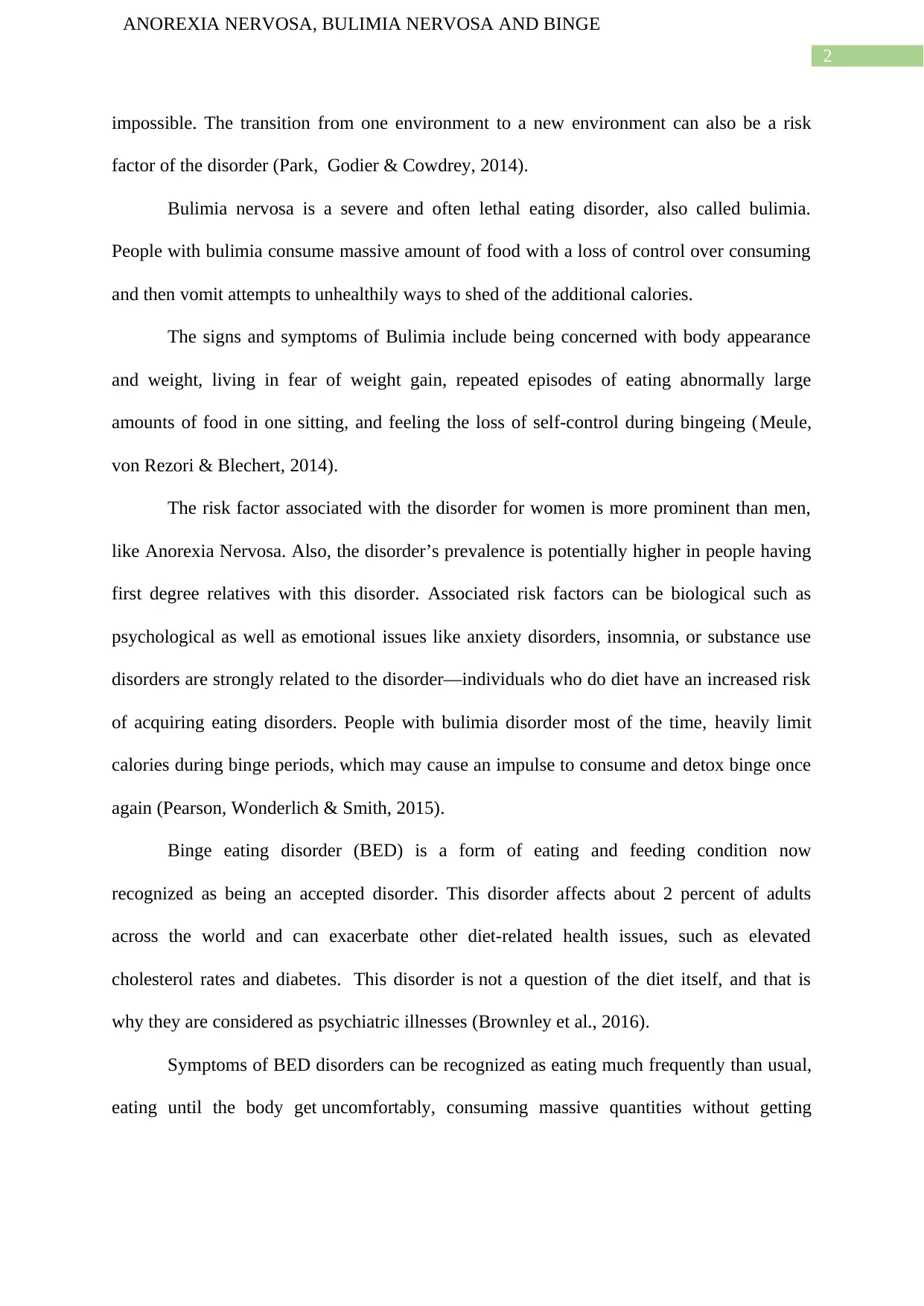
2
ANOREXIA NERVOSA, BULIMIA NERVOSA AND BINGE
impossible. The transition from one environment to a new environment can also be a risk
factor of the disorder (Park, Godier & Cowdrey, 2014).
Bulimia nervosa is a severe and often lethal eating disorder, also called bulimia.
People with bulimia consume massive amount of food with a loss of control over consuming
and then vomit attempts to unhealthily ways to shed of the additional calories.
The signs and symptoms of Bulimia include being concerned with body appearance
and weight, living in fear of weight gain, repeated episodes of eating abnormally large
amounts of food in one sitting, and feeling the loss of self-control during bingeing (Meule,
von Rezori & Blechert, 2014).
The risk factor associated with the disorder for women is more prominent than men,
like Anorexia Nervosa. Also, the disorder’s prevalence is potentially higher in people having
first degree relatives with this disorder. Associated risk factors can be biological such as
psychological as well as emotional issues like anxiety disorders, insomnia, or substance use
disorders are strongly related to the disorder—individuals who do diet have an increased risk
of acquiring eating disorders. People with bulimia disorder most of the time, heavily limit
calories during binge periods, which may cause an impulse to consume and detox binge once
again (Pearson, Wonderlich & Smith, 2015).
Binge eating disorder (BED) is a form of eating and feeding condition now
recognized as being an accepted disorder. This disorder affects about 2 percent of adults
across the world and can exacerbate other diet-related health issues, such as elevated
cholesterol rates and diabetes. This disorder is not a question of the diet itself, and that is
why they are considered as psychiatric illnesses (Brownley et al., 2016).
Symptoms of BED disorders can be recognized as eating much frequently than usual,
eating until the body get uncomfortably, consuming massive quantities without getting
ANOREXIA NERVOSA, BULIMIA NERVOSA AND BINGE
impossible. The transition from one environment to a new environment can also be a risk
factor of the disorder (Park, Godier & Cowdrey, 2014).
Bulimia nervosa is a severe and often lethal eating disorder, also called bulimia.
People with bulimia consume massive amount of food with a loss of control over consuming
and then vomit attempts to unhealthily ways to shed of the additional calories.
The signs and symptoms of Bulimia include being concerned with body appearance
and weight, living in fear of weight gain, repeated episodes of eating abnormally large
amounts of food in one sitting, and feeling the loss of self-control during bingeing (Meule,
von Rezori & Blechert, 2014).
The risk factor associated with the disorder for women is more prominent than men,
like Anorexia Nervosa. Also, the disorder’s prevalence is potentially higher in people having
first degree relatives with this disorder. Associated risk factors can be biological such as
psychological as well as emotional issues like anxiety disorders, insomnia, or substance use
disorders are strongly related to the disorder—individuals who do diet have an increased risk
of acquiring eating disorders. People with bulimia disorder most of the time, heavily limit
calories during binge periods, which may cause an impulse to consume and detox binge once
again (Pearson, Wonderlich & Smith, 2015).
Binge eating disorder (BED) is a form of eating and feeding condition now
recognized as being an accepted disorder. This disorder affects about 2 percent of adults
across the world and can exacerbate other diet-related health issues, such as elevated
cholesterol rates and diabetes. This disorder is not a question of the diet itself, and that is
why they are considered as psychiatric illnesses (Brownley et al., 2016).
Symptoms of BED disorders can be recognized as eating much frequently than usual,
eating until the body get uncomfortably, consuming massive quantities without getting
⊘ This is a preview!⊘
Do you want full access?
Subscribe today to unlock all pages.

Trusted by 1+ million students worldwide
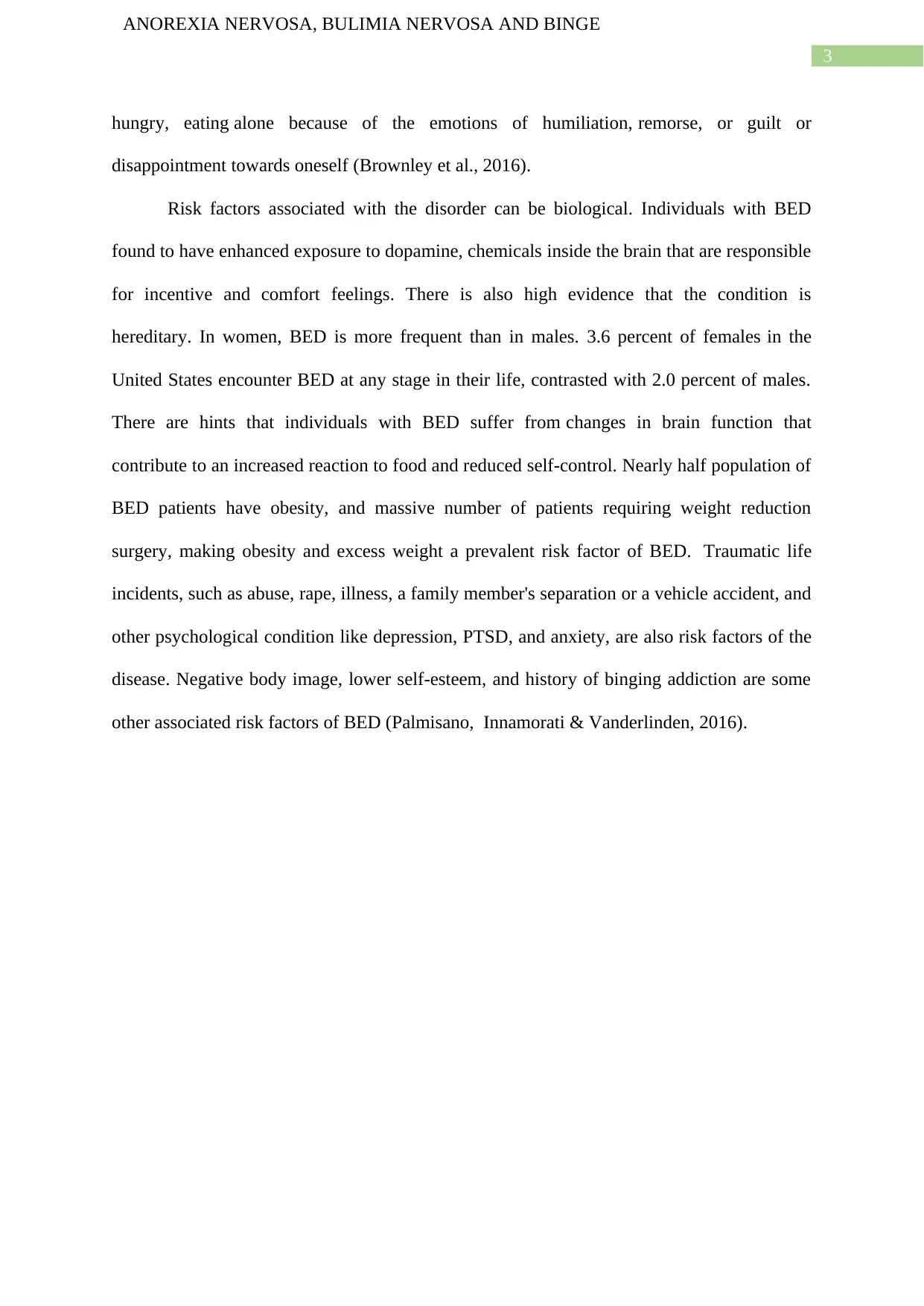
3
ANOREXIA NERVOSA, BULIMIA NERVOSA AND BINGE
hungry, eating alone because of the emotions of humiliation, remorse, or guilt or
disappointment towards oneself (Brownley et al., 2016).
Risk factors associated with the disorder can be biological. Individuals with BED
found to have enhanced exposure to dopamine, chemicals inside the brain that are responsible
for incentive and comfort feelings. There is also high evidence that the condition is
hereditary. In women, BED is more frequent than in males. 3.6 percent of females in the
United States encounter BED at any stage in their life, contrasted with 2.0 percent of males.
There are hints that individuals with BED suffer from changes in brain function that
contribute to an increased reaction to food and reduced self-control. Nearly half population of
BED patients have obesity, and massive number of patients requiring weight reduction
surgery, making obesity and excess weight a prevalent risk factor of BED. Traumatic life
incidents, such as abuse, rape, illness, a family member's separation or a vehicle accident, and
other psychological condition like depression, PTSD, and anxiety, are also risk factors of the
disease. Negative body image, lower self-esteem, and history of binging addiction are some
other associated risk factors of BED (Palmisano, Innamorati & Vanderlinden, 2016).
ANOREXIA NERVOSA, BULIMIA NERVOSA AND BINGE
hungry, eating alone because of the emotions of humiliation, remorse, or guilt or
disappointment towards oneself (Brownley et al., 2016).
Risk factors associated with the disorder can be biological. Individuals with BED
found to have enhanced exposure to dopamine, chemicals inside the brain that are responsible
for incentive and comfort feelings. There is also high evidence that the condition is
hereditary. In women, BED is more frequent than in males. 3.6 percent of females in the
United States encounter BED at any stage in their life, contrasted with 2.0 percent of males.
There are hints that individuals with BED suffer from changes in brain function that
contribute to an increased reaction to food and reduced self-control. Nearly half population of
BED patients have obesity, and massive number of patients requiring weight reduction
surgery, making obesity and excess weight a prevalent risk factor of BED. Traumatic life
incidents, such as abuse, rape, illness, a family member's separation or a vehicle accident, and
other psychological condition like depression, PTSD, and anxiety, are also risk factors of the
disease. Negative body image, lower self-esteem, and history of binging addiction are some
other associated risk factors of BED (Palmisano, Innamorati & Vanderlinden, 2016).
Paraphrase This Document
Need a fresh take? Get an instant paraphrase of this document with our AI Paraphraser
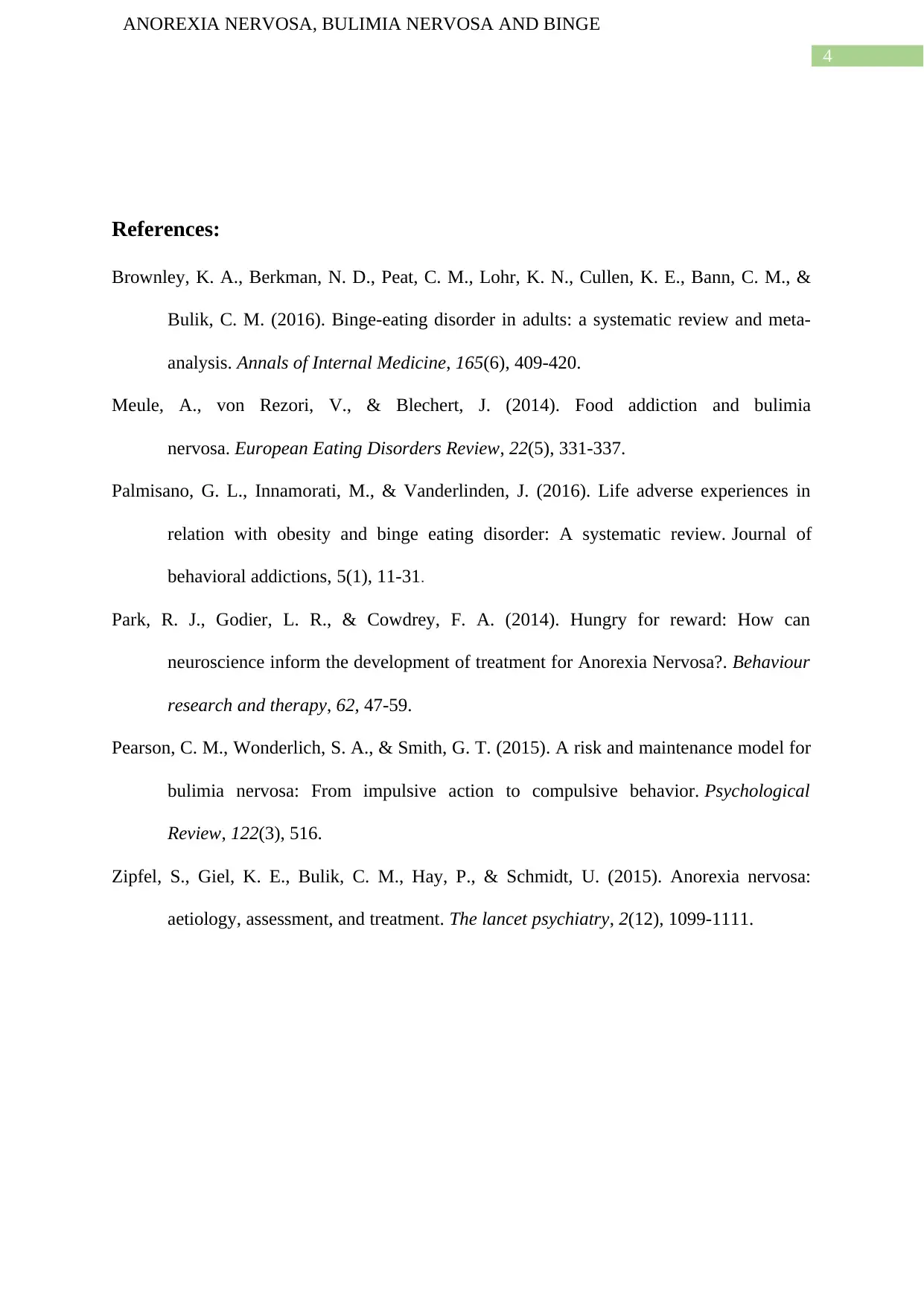
4
ANOREXIA NERVOSA, BULIMIA NERVOSA AND BINGE
References:
Brownley, K. A., Berkman, N. D., Peat, C. M., Lohr, K. N., Cullen, K. E., Bann, C. M., &
Bulik, C. M. (2016). Binge-eating disorder in adults: a systematic review and meta-
analysis. Annals of Internal Medicine, 165(6), 409-420.
Meule, A., von Rezori, V., & Blechert, J. (2014). Food addiction and bulimia
nervosa. European Eating Disorders Review, 22(5), 331-337.
Palmisano, G. L., Innamorati, M., & Vanderlinden, J. (2016). Life adverse experiences in
relation with obesity and binge eating disorder: A systematic review. Journal of
behavioral addictions, 5(1), 11-31.
Park, R. J., Godier, L. R., & Cowdrey, F. A. (2014). Hungry for reward: How can
neuroscience inform the development of treatment for Anorexia Nervosa?. Behaviour
research and therapy, 62, 47-59.
Pearson, C. M., Wonderlich, S. A., & Smith, G. T. (2015). A risk and maintenance model for
bulimia nervosa: From impulsive action to compulsive behavior. Psychological
Review, 122(3), 516.
Zipfel, S., Giel, K. E., Bulik, C. M., Hay, P., & Schmidt, U. (2015). Anorexia nervosa:
aetiology, assessment, and treatment. The lancet psychiatry, 2(12), 1099-1111.
ANOREXIA NERVOSA, BULIMIA NERVOSA AND BINGE
References:
Brownley, K. A., Berkman, N. D., Peat, C. M., Lohr, K. N., Cullen, K. E., Bann, C. M., &
Bulik, C. M. (2016). Binge-eating disorder in adults: a systematic review and meta-
analysis. Annals of Internal Medicine, 165(6), 409-420.
Meule, A., von Rezori, V., & Blechert, J. (2014). Food addiction and bulimia
nervosa. European Eating Disorders Review, 22(5), 331-337.
Palmisano, G. L., Innamorati, M., & Vanderlinden, J. (2016). Life adverse experiences in
relation with obesity and binge eating disorder: A systematic review. Journal of
behavioral addictions, 5(1), 11-31.
Park, R. J., Godier, L. R., & Cowdrey, F. A. (2014). Hungry for reward: How can
neuroscience inform the development of treatment for Anorexia Nervosa?. Behaviour
research and therapy, 62, 47-59.
Pearson, C. M., Wonderlich, S. A., & Smith, G. T. (2015). A risk and maintenance model for
bulimia nervosa: From impulsive action to compulsive behavior. Psychological
Review, 122(3), 516.
Zipfel, S., Giel, K. E., Bulik, C. M., Hay, P., & Schmidt, U. (2015). Anorexia nervosa:
aetiology, assessment, and treatment. The lancet psychiatry, 2(12), 1099-1111.

5
ANOREXIA NERVOSA, BULIMIA NERVOSA AND BINGE
ANOREXIA NERVOSA, BULIMIA NERVOSA AND BINGE
⊘ This is a preview!⊘
Do you want full access?
Subscribe today to unlock all pages.

Trusted by 1+ million students worldwide
1 out of 6
Related Documents
Your All-in-One AI-Powered Toolkit for Academic Success.
+13062052269
info@desklib.com
Available 24*7 on WhatsApp / Email
![[object Object]](/_next/static/media/star-bottom.7253800d.svg)
Unlock your academic potential
Copyright © 2020–2025 A2Z Services. All Rights Reserved. Developed and managed by ZUCOL.





